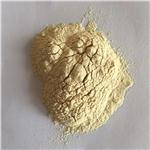- Carrageenan
-

- $10.00 / 1KG
-
2025-06-24
- CAS:11114-20-8
- Min. Order: 1KG
- Purity: 99%
- Supply Ability: 10 mt
- κ-Carrageenan
-

- $0.00 / 1kg
-
2025-06-23
- CAS:11114-20-8
- Min. Order: 1kg
- Purity: 0.99
- Supply Ability: 50000kg
- κ-Carrageenan
-

- $99.00/ kg
-
2025-06-10
- CAS:11114-20-8
- Min. Order: 0.001kg
- Purity: 99%
- Supply Ability: 5000
|
| | κ-Carrageenan Basic information | | Uses |
| | κ-Carrageenan Chemical Properties |
| solubility | H2O: 5 mg/mL hot, soluble | | form | Solid | | color | White to almost white to yellow to brownish | | biological source | plant | | Water Solubility | H2O: soluble 5mg/mL (hot) | | Merck | 14,1864 |
| WGK Germany | 2 | | RTECS | FI0704000 | | F | 3 | | HS Code | 13023990 | | Toxicity | rabbit,LDLo,intravenous,3mg/kg (3mg/kg),BLOOD: CHANGE IN CLOTTING FACTORS,Journal of Pharmacy and Pharmacology. Vol. 17, Pg. 647, 1965. |
| | κ-Carrageenan Usage And Synthesis |
| Uses | κ-Carrageenan is a sulfated linear polysaccharide of D-galactose and 3,6-anhydro-D-galactose extracted from certain red seaweeds of the Rhodophyceae class. κ-Carrageenan is used in the food industry as thickening, gelling and protein-suspending agents, and by the pharmaceutical industry in pills and tablets. | | Chemical Properties | sulfate content 20-36%, forms gels powder | | Uses | κ-?Carrageenan is a sulfated linear polysaccharide of D-?galactose and 3,?6-?anhydro-?D-?galactose extracted from certain red seaweeds of the Rhodophyceae class. κ-?Carrageenan is used in the food industry as thickening, gelling and protein-?suspending agents, and by the pharmaceutical industry in pills and tablets. | | Uses | The carrageenans are sulphate gums found in members of the Rhodophyceae. They consist of mixtures of polysaccharides which are mainly composed of D-galactose units linked 1~3 and 1~4. A high proportion ofthe units are substituted with sulphate half-ester groups. The carrageenans are useful stabilisers in foods. | | Definition | A naturally occurringpolysaccharide isolated from redalgae. The polymer is composed of dgalactoseunits, many of which aresulphated. K-carrageenan is a gellingagent with uses similar to those ofagar. | | in vivo | κ-Carrageenan can be used in animal modeling to create paw edema, colitis, and thrombosis models. κ-Carrageenan has oral activity; after oral administration, its concentration in BALB/c mice peaks at 3 hours, with an average residence time of 36.6 hours and a clearance rate of 0.1 L/h/kg. Most of the κ-Carrageenan is excreted via feces, while 9.2% is excreted through urine, indicating rapid absorption, slow elimination, and prolonged retention in the body. Additionally, κ-Carrageenan accumulates in the liver and kidneys. After 14 days of oral administration of κ-Carrageenan, hepatocyte necrosis, renal tubular vacuolation, and incomplete colonic epithelial cells are observed. Four hours after intraperitoneal injection of κ-Carrageenan, minor infarcts and erythema appear at the tips of rat tails, with infarct length increasing in a time-dependent manner and stabilizing 24 hours post-injection. Twenty-four hours is determined as the time point for successful establishment of the thrombosis model[4][5][6][7][8][9].
Induction of paw edema[5][6] Background
κ-Carrageenan induces paw edema by promoting the release of pro-inflammatory factors, leading to localized inflammation.
Specific Modeling Methods
Rat: Wistar ? male ? 80-110 days old ? 240-285 g
Administration: 0.1 mL ? sc ? single dose
Note
κ-Carrageenan is suspended in 0.5% Ringer's solution at a concentration of 1%.
Modeling Indicators Phenotypic observation: Increased foot volume between the ankle joint and the tibiotarsal joint.
Molecular changes: Neutrophil migration to the foot area of rats injected with κ-carrageenan, along with elevated expression levels of pro-inflammatory factors such as bradykinin, histamine, tachykinins, complement, and reactive oxygen species.
Correlated Product(s): / Opposite Product(s): /
Induction of colitis[7][8] Background
κ-Carrageenan induces the expression of pro-inflammatory factors by promoting interactions between intestinal epithelial cells and immune cells (macrophage-like THP-1 cells), thereby disrupting the integrity and function of the intestinal epithelial cells. κ-Carrageenan can also enhance the induction of colitis in mice by TNBS through the activation of the TLR4-NF-κB and MAPK/ERK1/2 pathways.
Specific Modeling Methods
Mice: C57BL/6J ? male and female ? 20-25 g ? 6-week-old
Administration: 1.7, 8.3, 41.7 mg/kg ? po ? single dose
Note
κ-Carrageenan is dissolved in physiological saline.
Modeling Indicators Phenotypic observation: Weight loss in mice, slight shortening and thickening of the distal colon, with colonic edema and hemorrhage. Damage to the surface of epithelial mucosal cells and disintegration of microvilli.
Molecular changes: Significant upregulation of IL-2, TNF-α, and IL-6 expression, with a notable decrease in IL-10 expression. The enzymatic activity of SOD and GSH-px in the colonic mucosa is reduced, while the expression of TLR4, NF-κB, p-ERK, p-JNK, p-Jun, IL-8, and MDA is upregulated.
Correlated Product(s): TNBS (2,4,6-Trinitrobenzene Sulfonic Acid) Opposite Product(s): /
Induction of thrombosis[9] Background
κ-Carrageenan induces thrombosis by causing localized vascular inflammation and endothelial cell damage through the release of inflammatory factors.
Specific Modeling Methods
Rat: Wistar ? male ? 150-160 g ? 7-week-old
Administration: 20 mg/kg ? ip ? single dose
Note
κ-Carrageenan is dissolved in physiological saline.
Modeling Indicators Phenotypic observation: Swelling, redness, and thrombosis in the tails of rats.
Coagulation parameter changes: In the tails of rats with thrombus formation, prothrombin time (PT) and fibrinogen (FIB) significantly increased, while thrombin time (TT) significantly decreased, as determined by classical coagulation testing methods.
Correlated Product(s): / Opposite Product(s): Aspirin Eugenol Ester | Animal Model: | Male and female NIH (s) mice[2] | | Dosage: | 1.7?mg/kg, LOW; 8.3?mg/kg, MED; or 41.7?mg/kg, HIG | | Administration: | Orally administered for 1 week prior to C. freundii DBS100 treatment | | Result: | Enhanced the C. freundii DBS100-dependent induction of TLR4 and NF-κB in the intestinal mucosa of infected mice.
|
|
| | κ-Carrageenan Preparation Products And Raw materials |
|